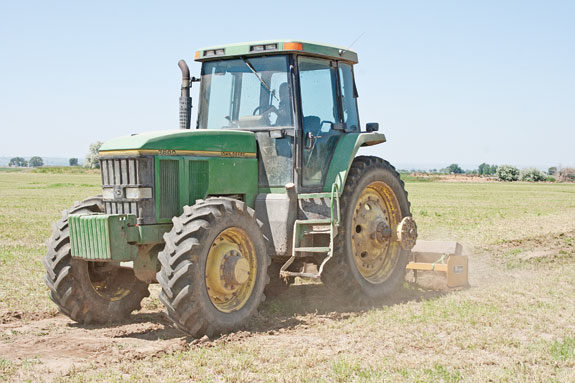Below I have included a short list of items to include in a checklist while you inspect your crop fields.
Pivot tracks and vibrations
One goal for any forage producer when it comes to planting and harvesting crops is to have and maintain a smooth field throughout the crop season.
In the past I have mentioned how much damage vibrations can cause to farm equipment.
However, in situations where you have a pivot irrigation system, it is important to monitor more than just the pivot itself. Limit vibrations as much as possible by filling in the tracks pivots leave behind.
For example, corn producers have big corn planters that have to run across the fields. To make a profit, these machines have to run between 5.5 and 6 mph.
If you want to run that piece of equipment at 6 mph, it is vital to make sure pivot tracks are filled in, rocks are picked up and the field is leveled before planting time.
You could compare this with guys that work in road construction. These workers spray water on the road and then pack the materials.
You’re virtually doing this out in your field when you run pivots or even by running equipment across the fields more than necessary. If the ground is just a little wet, you will be setting up that ground like a roadway.
Using an aerator
Dragging an aerator across your fields is a way to help reduce soil compaction and increase water flow. Aerators have spikes that jab into the ground and pull up plugs of dirt, allowing water to seep in.
The soil in the Magic Valley of Idaho is very forgiving because it has some sand mixed in it. However, other places have heavier soils that become compacted very easily.
Avoid risers
Make sure to mark the places in the fields where you don’t want equipment to go.
A friend of mine once hit a riser, which ended up costing him close to $1,200 to put all back together. He had to get somebody to go dig up the riser and then fix it.
A suggestion I give to avoid this is to get white five-gallon buckets and stick them on top of the risers. Equipment operators can spot these white buckets from a distance a lot easier and go around them. The white buckets will stand out from the green fields.
Protecting investments
There are many custom planters in the Magic Valley of Idaho. The goal for these planters is to do as good of a job as possible, working as much area (acreage) as possible; that way their customers aren’t having to wait on them.
One thing forage producers have to remember is that those guys have a lot of money wrapped up in their planting and harvesting equipment.
They probably also have quite a few customers that need their crops harvested. If the fields are in bad shape, causing damage to their equipment, they will most likely not be working for you the next year.
If it’s your piece of equipment, you would want the fields to be smooth, wouldn’t you?
I have seen many producers that have their own equipment go out and make sure all the rocks are picked up and the pivot tracks are filled, which protects the capital they have invested in their equipment. Some forage producers even pick rocks two to three times in the spring.
Help out
If you do have a custom harvester working for you, don’t be afraid to help them out if there are some places in the fields that could cause problems. In the end, if their equipment breaks down due to the condition of your fields, it will be your crop just sitting there instead of being harvested.
Conclusion
In conclusion, a little preparation and a little thought can have a big impact on your bottom line. Keeping the ground as level as possible and in good shape throughout the year will be your best bet in avoiding unnecessary equipment and operating costs.
I hope these tips help make your fields a smoother place to work on throughout the remainder of this season and in the future. FG
Mechanic’s tip: If you have a field that is adjacent to a highway, make sure to keep an eye out for random pieces of steel. When a radial steel tire blows out on a vehicle, most of the pieces from the tire’s sidewall end up in the field, which could cause damage to your equipment.











